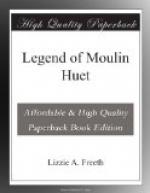LIZZIE A. FREETH
Author Of The Adventures of Carl Skinflint among the Fairies
Guernsey: Le Lievre, Printer, Star-Office,
10, Bordage Street.
1872
Dedicated to
“The Conway
boys.”
DEDICATION.
Though the story contained in the following pages has no connection with them, yet it is my wish to dedicate this little work to “The Conway Boys,” and all those connected with that most invaluable institution, “H.M.S. Conway,” lying at Rockferry, Birkenhead.
I have particular reason to speak well of the “Conway,” as any “Boy” may know who may have been on board for the last five or six years, from the fact that two of my brothers, after passing a successful career under the careful teaching of the Rev. Henry O’Brien; L.L.D., Cork, continued to build on the good foundation laid, and left the “Conway” with credit both to their teachers and themselves. I shall always have pleasure in meeting with any “Conway Boy,” and hearing of the good old ship to which I wish a long continuance of her success in preparing Boys creditably for one of the great sources of our national strength and wealth—“Our Merchant Navy.”
I must just add a word of thanks to my friends in Guernsey and elsewhere, who so kindly encouraged and supported me when publishing on a former occasion, and whom I see, by reference to the subscription list, coming forward again—among some new friends—with a repetition of their kindness.
Montpelier, Guernsey, 1872.
CHAPTER I.
In the year 165-, when Cromwell had gained ascendancy in England and over the greater portion of the Channel Islands, there lived in Guernsey, at the Bay of Moulin Huet, a miller of the name of Pierre Moullin. Unlike his class generally, he was a very morose man, hard in his dealings with the poor around him, and exceedingly unsympathizing in all his domestic relations, as will appear as our story unwinds itself. Before speaking of the family surroundings of Pierre Moullin we will glance at the circumstance which forms the basis of the present tale. Visitors to the Bay of Moulin Huet, as well as to other parts of this and the surrounding Islands, may have observed a crimson appearance on the rocks, suggesting very sanguinary ideas, but for which, geologists doubtless, would be able to account in a very satisfactory manner. Looking at a portion of the original gully through which the water runs after passing through the mill wheel, we find that this crimson appearance is very visible, and as our purpose is not to raise scientific enquiries, we will take one of the fanciful reasons (of which there are two or three in existence), for this coloring on by the hand of Nature, which has so abundantly bedecked Guernsey in general, and Moulin Huet in particular. Dipping into the Fairy lore of that part of the island, we find that many believe that some mischievous Fairies who annoyed the miller much with their nightly pranks were ground to pieces by the mill wheel becoming unfastened, and that their blood remains there to this day, as a warning to all others among the “good people” who might wish to vent their superfluous mischief in a like manner.




